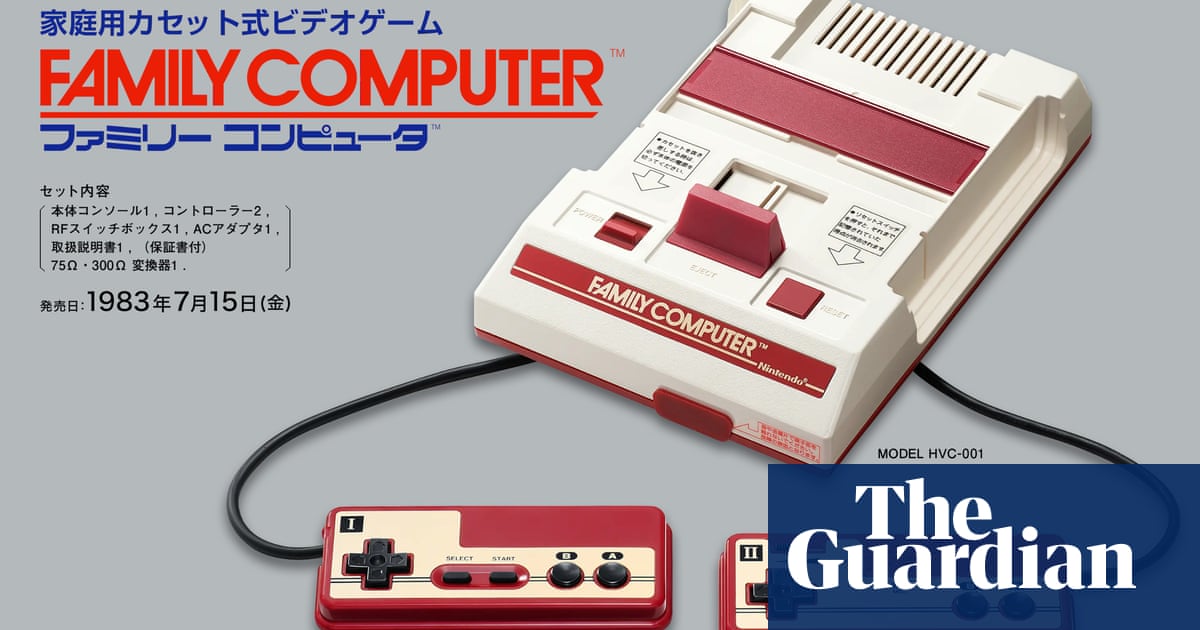
When the Nintendo Famicom, known abroad as the Nintendo Entertainment System, was launched on 15 July 1983, it entered a market crowded with formidable rivals. Six other consoles were released in Japan that year, including the Sega SG-1000, which arrived on the same day and would later be redesigned as the Master System in the west. Also in the running were the My Vision from Nichibutsu, the Pyuta Jr. from Tomy and the PV-1000 from Casio – all major consumer electronics manufacturers. But it was the Famicom that became a sales phenomenon, shifting more than 2.5m units by the end of 1984 and completely dominating the Japanese games industry.
When it was redesigned as the NES and launched in the US in 1985, it revitalised the country’s flagging games sector after an infamous crash a few years earlier. Its reach was truly global: even in markets where the console wasn’t officially launched, bootlegged versions were rife. The Famicom is by far the most copied console of all time, and so called “Famiclones” are still being made now.
But despite birthing many franchises that are still enormously popular – Super Mario Bros, The Legend of Zelda, Metroid, Castlevania, Final Fantasy, Dragon Quest – the Famicom’s success was never guaranteed.
Card sharp
Nintendo was by no means the dominant player in video games at the time. Founded in 1889 as a manufacturer of hanafuda, Japanese playing cards, it diversified into toys in the 1960s, such as the popular Ultra Hand extendable grabber created by famed engineer Gunpei Yokoi. In the early 70s it produced laser shooting games for Japan’s burgeoning arcade scene. The company’s first console, the Color TV-Game 6, arrived in 1977, but this was just one of many similar machines; the success of Atari’s Pong had prompted an explosion in the manufacture of so-called “dedicated consoles”, hardwired to play a handful of games, usually variations on Pong. In Japan, at least a dozen companies were producing their own Pong consoles, including Tomy, Bandai, Epoch and Hitachi, and Nintendo released several variations of its own.
In the late 1970s, the company began producing arcade video games, but it had as many misses as hits. Who remembers Monkey Magic or Space Launcher? The watershed moment came in 1981 with the release of Donkey Kong, designed by a young Shigeru Miyamoto. The game marked the first appearance of Mario, then known as “Jumpman”, and went on to become one of the bestselling arcade games of all time. Not long after Donkey Kong’s release, Nintendo president Hiroshi Yamauchi ordered the development of a home console, which was codenamed Gamecom.
“A key driver for its design was to bring Donkey Kong into the home,” says Prof James Newman, a videogame researcher at Bath Spa University. Unlike Nintendo’s earlier dedicated consoles, the Gamecom would use programmable game cartridges that could be swapped in and out. The Fairchild Channel F was the first console to employ this feature back in 1976, and the Atari 2600, released the following year, would go on to sell millions in the US. But the console landscape was very different in Japan, where the Atari 2600 had made little impact when it was distributed by Epoch in 1979, rechristened as the Cassette TV Game. Instead, Epoch’s own machine, 1981’s Cassette Vision, was Japan’s most popular console.
But Nintendo’s would be far more powerful. Nintendo’s machine was based around a variant of the MOS Technology 6502 microprocessor, the same chip that was used in the Commodore 64, Apple II and many other machines of the time. But the real power lay in the graphics chip, the Picture Processing Unit (PPU), which was developed by Ricoh and shares some key similarities with the TMS9918 video display processor used in the US ColecoVision console. Nintendo’s R&D team had seen a prototype of the ColecoVision and had been impressed by its smoothly animated graphics.
Dawn of the Famicom
Development of the Gamecom was headed by Masayuki Uemura, whose wife suggested it should be renamed the Family Computer, or Famicom for short. Uemura has also revealed that the distinctive cream and dark red colour scheme of the Famicom was inspired by a scarf worn by Nintendo president Hiroshi Yamauchi.
“One of the things I really like about that story is that it reminds you of how few people were involved in this,” says Newman, who met Uemura on several occasions. “It’s not the product of endless focus group testing.”
Other design decisions were similarly domestic. The Famicom had unremovable controllers with fairly short leads because the designers expected the console to be placed on the floor in front of the TV, with the players sitting on the floor in front of it, says Newman – though having permanently connected controllers made them difficult to replace if one developed a fault. He says: “In terms of repairs, it wasn’t the greatest design choice.”
The fact that the Famicom would be sat on the floor also led to another design decision. Until that point, almost all console controllers used a joystick, but the Famicom used a D-pad, or directional pad, which would become ubiquitous.
“Part of the reason for exploring the cross key, or the D-pad, rather than a joystick was that the controllers would get trodden on,” says Newman. Nintendo pioneered the D-pad with the Donkey Kong Game and Watch handheld in 1982, and the company issued a patent on the technology which would last for the next 20 years. To avoid violating the patent, rival console manufacturers had to make their D-pads circle-shaped rather than cross-shaped.
One novel feature of the Famicom was that the second controller featured a microphone. In a talk at the National Videogame Museum in Sheffield in early 2020, Uemura said that karaoke was big in Japan at the time, and they thought that developers might create karaoke titles. In the end, only a handful of games used the microphone, most notably The Legend of Zelda in 1986; the manual for the game hinted that an enemy called Pols Voice “hates loud noise”, and it could be defeated by shouting into the microphone. The microphone was dropped when the Famicom was redesigned as the NES, although it would eventually make a comeback on the Nintendo DS.
The launch lineup included home conversions of Nintendo’s arcade hits Donkey Kong, Donkey Kong Jr and Popeye, but the console soon evolved past coin-op conversions, which were designed around short play sessions. Having games in the home meant they could become bigger and more complicated.
“We start to see innovations around passwords to allow you to pick up your game from a later point, or battery backup to save your progress,” says Newman. “Suddenly you get the possibility of creating a different kind of game.”
The big breakthrough came with the release of Super Mario Bros in 1985, which would go on to sell more than 40m copies, partly as a result of being bundled with the console. The following year saw the release of The Legend of Zelda, also designed by Shigeru Miyamoto, as well as the classic Nintendo titles Metroid and Kid Icarus.
The Famicom’s enormous popularity meant that developers such as Capcom, Konami, Square and Taito were clamouring to get their games released on the console, and, unlike Atari, which had actively tried to stop other companies from releasing games on its system, Nintendo embraced them. However, Nintendo imposed strict terms, including limiting the number of games each company could publish every year, forbidding them from releasing the same game on rival platforms, and insisting on manufacturing the cartridges in-house, charging the publisher upfront. But such was the monopoly of the Famicom that publishers queued up to comply, and third-party titles such as Dragon Quest, Final Fantasy, Castlevania, Mega Man, Bomberman, Contra and Metal Gear became huge hits on the console.
The rest is NES-story
When the Famicom was launched as the NES in the US in 1985, it was a much bigger, boxier machine that more closely resembled a VHS player. This was a deliberate move on Nintendo’s part, as it tried to reposition the machine as an “entertainment system” rather than a console.
Following the collapse of the US console market in 1983, retailers had been left with warehouses full of unsaleable cartridges and consoles, and Nintendo had to convince them that the NES was different. In the end, the NES completely dominated the US market, ending up in about 30% of US homes by the end of 1990. It also became a huge hit in Europe, although not quite to the same extent; in the UK in particular it would regularly be outsold by the Sega Master System.
Nintendo of America finally stopped manufacturing the NES in 1995, but the Famicom lived on much longer, with production continuing right up until 2003. Between them, the NES/Famicom sold more than 60m units, and it’s still popular today. It was rereleased as the Famicom Mini in 2016, selling out almost immediately, and third-party reproductions of the console are available in a wild range of forms, the patents on the technology having long since expired. Perhaps most importantly, the influence of the Famicom continues to live on in modern consoles.
“If you look at any contemporary game controller, it’s a Famicom controller in some way,” says Newman, noting that the console established the blueprint of button layouts and the D-pad. “The legacy of the Famicom is pretty much all of the gaming devices that we have in our living rooms today.”
This article was amended on 18 July 2023. The Nintendo Famicon was launched in 1983, not 1973 as an earlier version of the caption on the main image said.












